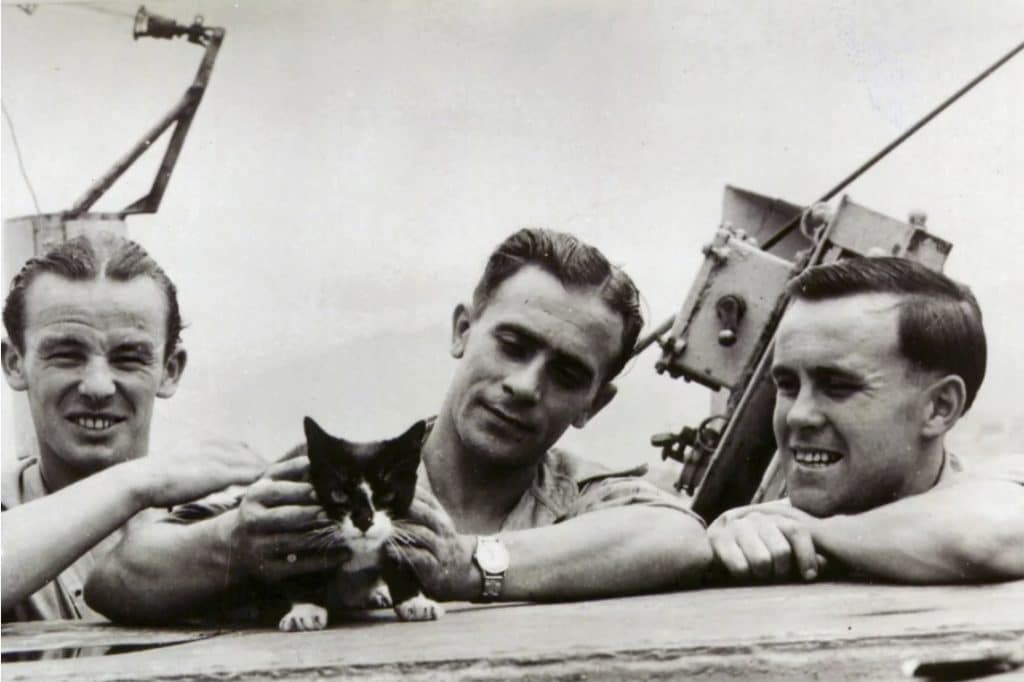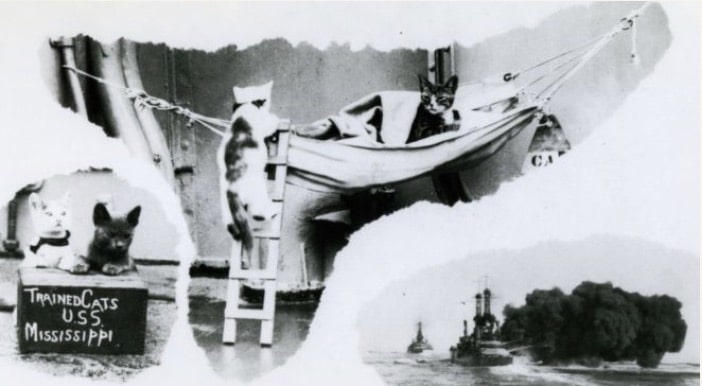[ad_1]
In the not-so-distant previous I used to be lolling on a wonderful seaside in Oaxaca when a person and a tender boy approached me with an armful of colourful hammocks. These had been too huge to have compatibility in my carry-on so I with courtesy declined. The boy had my quantity, although. He reached right into a bag slung over his small shoulders and introduced me with various teeny, tiny hammocks. I stated, “Well I can fit one of those in my bag for sure, but what would I put in such a tiny hammock?”
“Cats”, he answered.
SOLD.
Cat hammocks abound on the web as a result of, actually, cats can and will sleep anyplace. But the cat hammock in fact took place in a much more sensible means–as a spot for cats to sleep aboard boats. In specific, Navy vessels.
For years sailors have followed cats to function group on ships, offering a lot wanted companionship in addition to authentic tasks as rodent patrol. Scot Christenson, writing in Naval History Magazine, additionally notes that “Superstitious sailors believed that cats protected them by bringing good luck. Others thought that the keen eyesight of cats would help guide them in a shipwreck at night, because a cat can more easily detect distant lights.”
One crusing cat, Simon (above), even gained an authentic medal for his accountability aboard the HMS Amethyst, a British Navy frigate. Originally followed via the group as a stray from Hong Kong in 1948, Simon’s candy, grumpy face used to be an actual morale-builder and he made speedy pals aboard the send.
In the summer time of 1949 the HMS Amethyst got here beneath fireplace whilst patrolling the Yangtze river. The send took over 50 direct hits, killing its captain, injuring deficient Simon, and leaving the send and group stranded for 10 weeks. The scorching, humid climate used to be ripe for a rat infestation and the stranded sailors lived in concern that the rats would devour via their meager provisions. But Simon, regardless of shrapnel wounds and burns to his legs, again, and face, unmarriedpawedly safe his fellow sailors’ treasured stockpile.
Once the disaster used to be over, Simon used to be awarded an Amethyst marketing campaign ribbon for “distinguished and meritorious service.” Sadly, upon getting back from combat in November of 1949, Simon succumbed to an an infection led to via his warfare wounds. Hundreds of folks, together with the whole thing of the HMS Amethyst group, attended Simon’s funeral on the PDSA animal cemetery in Ilford, England. His headstone notes, “HIS BEHAVIOUR WAS OF THE HIGHEST ORDER.”
While cats on ships had been certainly helpful—even heroic—it is going with out announcing that their primary process used to be the similar as it’s as of late: being the cutest factor ever. Here’s a glance again on the ancient happiness this is send’s cats in hammocks (impressed via nice collection of Tweets via Molly Hodgdon):
Tiny buddy of HMCS Iroquois. 1944. %.twitter.com/jtSsPXIca8
— Molly Hodgdon (@Manglewood) July 2, 2021
This little butterbean watches over his group as they sleep aboard the Royal Canadian Navy destroyer HMCS Iroquois in 1944.
Two potatoes in a sling. HMAS Nizam, 1941. %.twitter.com/RRvwRmVK6C
— Molly Hodgdon (@Manglewood) July 2, 2021
A double-stuffed cat hammock at the Royal Australian Navy send HMAS Nizam, 1941.
Good information: I’ve accumulated a host of footage of naval send cats in tiny hammocks. Here are sailors of the HMS Hermione in 1941 surrounding their drowsing cat, Convoy. %.twitter.com/X1iAaezxk5
— Molly Hodgdon (@Manglewood) July 2, 2021
This little critter, named Convoy, clearly enthralled the sailors aboard the British Navy frigate HMS Hermione in 1941.
Crew member of HMS Warspite asleep with the send’s mascot kitten in its hammock, 1944. %.twitter.com/QVlDziqWz0
— Molly Hodgdon (@Manglewood) July 2, 2021
Nothing however candy goals at the Queen Elizabeth-class battleship HMS Warspite in 1944.
Kitten aboard HMS Achilles ca. 1939. %.twitter.com/4452m6nxdM
— Molly Hodgdon (@Manglewood) July 2, 2021
This good-looking sailor helps to keep an eye fixed out for motion aboard the Royal New Zealand Navy send HMS Achilles in 1939.
Saipan of the USS New Mexico. %.twitter.com/vjisrV3mfs
— Molly Hodgdon (@Manglewood) July 2, 2021
This little calico, named Saipan, introduced pleasure to sailors aboard the battleship USS New Mexico.
Thomas of HMS Shropshire were given an entire bedtime collection. %.twitter.com/iIzTQrza8G
— Molly Hodgdon (@Manglewood) July 2, 2021
Thomas, of the HMS Shropshire, used to be clearly coddled.
Kitten on HMAS Kanimbla sooner or later throughout WWII. %.twitter.com/Xt36krkK1g
— Molly Hodgdon (@Manglewood) July 2, 2021
Sailoring is tricky paintings for this little chonk aboard the HMAS Kanimbla, a touchdown platform amphibious send operated via the Royal Australian Navy.
Kitten mascot of the airplane service HMS Eagle, ca. 1945. %.twitter.com/QDCARxVsQG
— Molly Hodgdon (@Manglewood) July 2, 2021
Dreaming of remote shores aboard the HMS Eagle in 1945. Don’t you simply love how this kitty additionally has a tiny pillow?
And finally, the well-known “Trained Cats of the USS Mississippi” in 1925. So liked that they even were given their very own tiny cat ladder for more straightforward tiny cat hammock get right of entry to.
Thank you in your provider, top seas kitties.
Further Reading
[ad_2]





